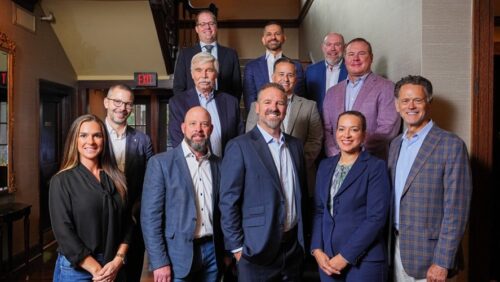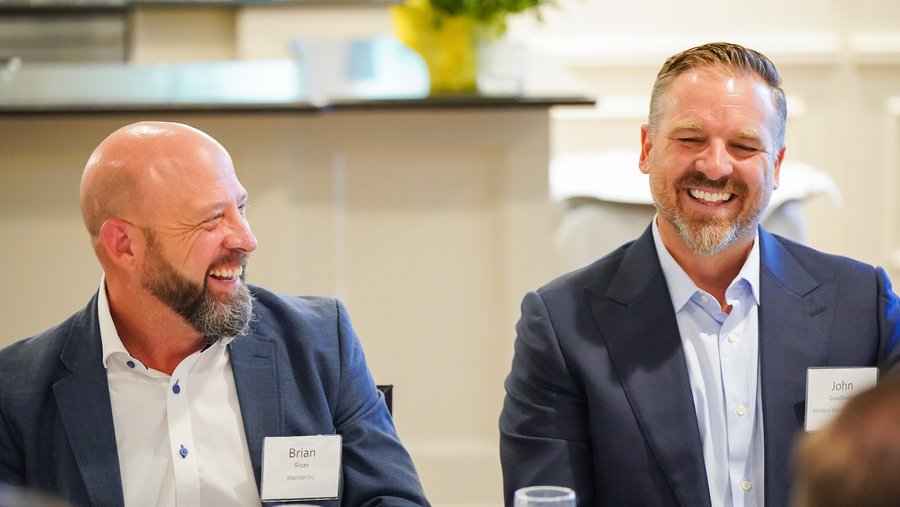
10.7.24 – The Business Journals
If the economy is cooling, some Kansas City-area companies have yet to feel a chill.
McCownGordon Construction has a $2.6 billion backlog that will carry the commercial construction manager through 2027. And with interest rates coming down — encouraging companies and developers to spend cash — plus trillions of federal dollars waiting to be spent, the company forecasts heat for the foreseeable future.
“We feel pretty strongly that we’re going to start to see an uptick over the next two to four years as this money starts to get redeployed, so our strategy is just to stay out in front of it and try,” said McCownGordon CFO Jeff Placek. “Everybody’s got a record backlog in our business.”
Several local businesses have bullish projections, though certain sectors have experienced intermittent contraction, according to leaders from a cross-section of Kansas City’s top 150 private companies. They discussed current conditions at a roundtable hosted by Bank of Blue Valley and moderated by the Kansas City Business Journal.
Local companies’ biggest struggles center on the question of labor: getting creative about hiring, finding out how best to use the employees they have and deploying innovation to bridge the gap.
The economy: Chatter vs. reality
For the past couple of years, U.S. economists have floated the possibility of a recession. Yet despite some worrisome indicators — and the uncertainty of a looming presidential election — the economy thus far has shown resilience. Growth may slow, but it looks as if it will persist.
The U.S. unemployment rate reached 4.2% in August, compared with 3.7% in January, according to the U.S. Bureau of Labor Statistics. However, employers continue to add jobs, and the unemployment rate — which dipped to 4.1% in September — remains near historical lows.
On a broader scale, inflation is slowing, and the economy continues to expand, said Chris Bannister, head of commercial banking at Bank of Blue Valley.
The Federal Reserve’s decision in September to drop its key interest rate by half a percentage point was a welcome development.
“The phone has started ringing again about projects that didn’t pencil out before but are getting closer now,” Bannister said.
Aladdin Ashkar, the bank’s head of business banking, said he’s ready to get back to lending more money in 2025, investing in local businesses.
“Providing access to capital is one part of our jobs we enjoy the most,” he said.
The construction industry has been particularly robust, according to local company leaders.
“In our industry, it’s not slowing,” said Tirzah Gregory, group director for infrastructure design firm HNTB Corp. “And with the infrastructure bill that passed, there’s so much work and not enough people.”
Conditions have been more difficult for certain sectors.
High interest rates had weighed on companies such as Master’s Transportation Inc., which provides commercial vehicles for rent, lease or purchase.
“That’s been a painful play, with fixed contracts and interest fluctuation,” said Master’s CEO John Goodbrake.

But the company has taken a creative posture. It now travels with clients around the country instead of solely in the metro area. It also has extended sales responsibilities to all employees.
“Everybody in the company is responsible for keeping contact, bringing clients back and finding opportunities,” Goodbrake said. “As somebody who’s been on the sales end of our business for a long time, it’s been really gratifying to see people who are more operational take on more sales roles.”
Adam Hill, CEO of Scarbrough Global, described the past two years as miserable for logistics providers. Customers weren’t shipping anything; rather, they sold existing inventory that had built up during the pandemic. Domestic shipping prices dove by about three-quarters, hearkening back to the Great Recession of 2008.
Scarbrough hasn’t laid people off, preferring to weather a bad year to keep its people, but most peers have, Hill said.
Still, conditions show signs of life.
“We just now started to see some of that tick back up in maybe the last 30 days, and we’re typically six to nine months before everybody else,” Hill said. “So second quarter of next year, for us, is looking pretty promising.”
MMGY Global, a travel and tourism integrated marketing agency, has observed a hesitance to spend on leisure travel, said Craig Compagnone, MMGY’s president of the Americas. The softening predictably followed a huge post-pandemic boom.
However, corporate travel is a different story.
“Globally, we anticipate that the corporate travel sector will continue its phenomenal upswing for at least the next two to three years. Overall, long-term indicators for the vitality of the industry, especially on the corporate side, are really, really strong,” Compagnone said. “While consumer interest in leisure travel may be plateauing at the moment, marketers’ pursuit of that audience certainly hasn’t cooled.”
Labor: The ‘war for talent’
The labor question is complex, complicated by dramatic wage inflation, panelists said.
“The war on talent is very real,” McCownGordon’s Placek said.
Many of today’s workers want remote jobs — which gets complicated for companies whose industries limit that possibility, said Richard Wetzel, CEO of Centric Construction Group. The prevalence of remote work also means companies compete not just locally but nationally for talent.
Also, high school students tend to overlook the potential of skilled trades in favor of going to college.
Separately, immigration has become such a hot-button issue that the need for more workers gets missed, Wetzel said.
“Sometimes, the conversation we have, maybe even politically, is not aligned with what’s actually going on,” he said.
Much of companies’ energy goes toward seeking out talent or pursuing creative solutions for the dearth of it.
“The amount of work is not the problem,” said Brian Sloan, CEO of commercial technology integrator Wachter Inc. “I have as many people looking for people as I do people, and I can’t find them.”
Given those conditions, the company is transitioning to more artificial intelligence-compatible software to boost communication throughout its 16 offices and do more without requiring more people. Wachter also is “home growing” employees through measures such as an apprenticeship program for students coming out of high school, Sloan said.

Brad Clark, COO of JR & Co. Inc., said the company — which handles roofing and other building envelope needs — is bullish on the construction business but faces the challenge of sufficient labor and subcontractors.
“We have to do very, very aggressive vetting and testing, making sure we’ve got the capacity necessary,” Clark said.
Some companies have implemented self-insured health plans as an important perk to help attract and retain associates — and potentially save money.
Companies also are trying to make the most of the employees they have.
“We’re really investing more into people’s actual development — not just the training of project managers and superintendents, but leadership skills,” said JoLynne Bartolotta, vice president of business services for Fogel-Anderson Construction Co. “We’re getting them out there more in front of clients and making them take ownership of those relationships.”
The strategy also has helped drive the company’s growth, she said.
Fogel-Anderson also has been working with local industry organizations and career innovation centers to show students the potential of skilled trades jobs.
Strickland Construction, a design-build general contractor, emphasizes meaning and belonging with employees, said CEO and owner Rogers Strickland. Employees do company-funded mission work in Guatemala — and are paid while there.
In addition, he said, the company strives for a family feel through events such as a monthly companywide meal, hoping also to engage the next generation of workers.
“I think that’s one of the things that draws people to us,” Strickland said. “This trade you have is not just about making money — it’s about serving others.”
HNTB’s Gregory said she now spends about a quarter of her time on hiring, particularly with dramatic growth on the horizon. The company tries to differentiate itself through a strong, relational culture, but the hiring process consumes much thought, time and energy.
“For 2025, building up our labor force — our talent recruitment — is a huge focus,” she said.
